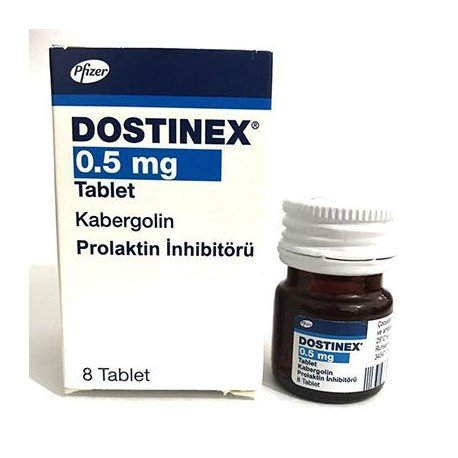Cabergoline is a dopamine and serotonin receptor agonist that inhibits prolactin secretion by the anterior pituitary. It is used to treat the following diseases:
-
Treatment for prolactinoma that is idiopathic or caused by a pituitary adenoma.
-
Given that prolactin is also involved in breastfeeding, it is possible to utilize it to prevent lactation when it is clinically necessary, such as in cases of stillbirth, neonatal death, mental illness, or other obstacles to nursing. (It is not indicated for the inhibition of physiologic lactation).
-
Off label Use of Cabergoline in Adults includes:
- Treatment of Acromegaly
- Cushing syndrome
- Restless legs syndrome
Cabergoline Dose in Adults
Cabergoline in the treatment of Hyperprolactinemia:
- 0.25 mg orally twice a week initially.
- The dose may be increased by 0.25 mg twice a week according to the patient's serum prolactin levels to a maximum dose of 1 mg twice a week.
- The efficacy of the drug after 2 years of use has not been established.
- The dose should not be increased more frequently than every four weeks.
- Once the serum prolactin level is maintained within the normal range for more than six months, the drug may be stopped and the levels should be monitored.
Use for the treatment of Lactation inhibition:
- 1 mg orally as a single dose on the first day of delivery.
Off-label use in the treatment of Acromegaly:
- 0.25 to 0.5 mg taken orally twice a week
- Depending on the blood levels of growth hormone and insulin-like growth factor 1 (IGF-1), adjust the dose every 4 to 6 weeks.
Off-label use in the treatment of Cushing syndrome:
-
0.5 mg taken orally once per week or 1 mg administered twice per week in split doses.
-
Up to full and persistent normalization of urinary free cortisol (UFC) levels, the dose may be raised by 0.5 to 1 mg weekly at one or two-month intervals.
-
The maximum dose utilized was 7 mg per week, administered as 1 mg once a day.
Off-label use in the treatment of Restless legs syndrome:
- 0.5 mg orally three hours before bedtime
- Titrate the dose in 0.5 mg increments every 3 - 7 days to the usual dose of 2 mg and a maximum dose of 7 mg.
Cabergoline Dose in Children
Safety and efficacy not established.
Pregnancy Risk Factor: B
- Although data is not available, it is believed that cabergoline can be used safely during pregnancy.
- Cabergoline can be used to treat hyperprolactinemia. However, it is better to use other agents.
- During pregnancy, monitoring serum prolactin levels could be suspended.
- It can also be used to treat acromegaly during pregnancy.
- It is not recommended that you monitor your IGF-1 and growth hormone levels during pregnancy.
- Patients with uncontrolled hypertension, pregnancy-induced hypertension, preeclampsia, and eclampsia or postpartum hypertension are not recommended to use it.
- Cabergoline can restore fertility to patients suffering from infertility.
Use of cabergoline during breastfeeding
- It is unknown if breastmilk contains cabergoline.
- It inhibits lactation so it shouldn't be used by women who want to breastfeed.
Cabergoline Dose in Renal Disease:
- Adjustment in the dose has not been provided by the manufacturer in patients with kidney disease.
Cabergoline Dose in Liver Disease:
- Adjustment in the dose has not been provided by the manufacturer.
- Liver functions should be monitored in patients with severe hepatic impairment.
Common Side Effects of Cabergoline Include:
- Gastrointestinal:
- Nausea
- Central nervous system:
- Headache
- Dizziness
Less Common Side Effects Of Cabergoline include:
- Cardiovascular:
- Orthostatic hypotension
- Peripheral edema
- Syncope
- Hypotension
- Palpitations
- Dermatologic:
- Acne vulgaris
- Pruritus
- Central nervous system:
- Fatigue
- Insomnia
- Lack of concentration
- Malaise
- Drowsiness
- Pain
- Nervousness
- Paresthesia
- Vertigo
- Depression
- Anxiety
- Endocrine & metabolic:
- Hot flash
- Dependent edema
- Genitourinary:
- Mastalgia
- Dysmenorrhea
- Gastrointestinal:
- Constipation
- Abdominal pain
- Diarrhea
- Flatulence
- Xerostomia
- Dyspepsia
- Vomiting
- Anorexia
- Toothache
- Neuromuscular & skeletal:
- Weakness
- Arthralgia
- Respiratory:
- Flu-like symptoms
- Rhinitis
- Throat irritation
- Ophthalmic:
- Periorbital edema
- Visual disturbance
Contraindication to Cabergoline Include:
- Allergy reactions to cabergoline derivatives or any component of this formulation
- Hypertension uncontrolled
- History of cardiac valvular diseases (valvulopathy, thickening, or mixed valve restriction syndrome)
- History of pericardial, retroperitoneal, or pulmonary fibrotic disorders.
Warnings and Precautions
- Cardiac valvulopathy:
- Cabergoline should not be prescribed to patients with valvular diseases.
- If an echocardiogram reveals a new valvular regurgitation or restriction, or if the valve leaflet thickening occurs, treatment should be stopped immediately
- It has been linked to cardiac valvulopathy.
- Before initiating treatment, a cardiovascular evaluation such as a chest x-ray or CT scan and an echocardiogram is required.
- Cardiovascular effects
- Patients suffering from stroke, hypertension, heart disease, or seizures should not take the drug.
- Higher doses (more than 1 mg) could be associated with orthostatic hypotension.
- Retroperitoneal and pleural fibrosis
- Patients who have a history of extracardiac or cardiac fibrotic disorders should not use the drug. It has been linked with pleural, retroperitoneal, and pericardial fibrosis.
- The drug could be discontinued if it causes improvement.
- CNS depression:
- Avoid using the drug if you are a heavy operator, or driver, or perform activities that require mental alertness.
- It should also be avoided in patients with concomitant use of benzodiazepines.
- Psychiatric disorders
- It is linked to aggression, psychotic behavior, and impulse control disorders such as pathological gambling, increased sexuality, compulsive buying or spending, and binging.
- Peptic ulcer disease:
- Patients suffering from peptic ulcer disease and gastrointestinal bleeding should be cautious when taking the drug.
- Hepatic impairment
- It is highly metabolized in the liver so it should be taken with caution
- Raynaud syndrome:
- Raynaud patients should be cautious when taking the drug.
Cabergoline: Drug Interaction
Note: Drug Interaction Categories:
- Risk Factor C: Monitor When Using Combination
- Risk Factor D: Consider Treatment Modification
- Risk Factor X: Avoid Concomitant Use
Risk Factor C (Monitor therapy). |
|
| Antiemetics (5HT3 Antagonists) | This may increase the serotonergic effects of Serotonin Activators. This could lead to serotonin syndrome. |
| Antipsychotic Agents | Antipsychotic Agents may have a greater adverse/toxic effect if they are regulated with serotonin modulators. Serotonin modulators can increase dopamine blockade and, therefore, may increase the risk of developing the neuroleptic malignant syndrome. Serotonin modulators may have a serotonergic effect that is enhanced by antipsychotic agents. This could lead to serotonin syndrome. |
| Chloroprocaine | May increase the hypertensive effects of Ergot Derivatives. |
| Clarithromycin | Cabergoline serum concentration may be increased |
| Metaxalone | This may increase the serotonergic effects of Serotonin Activators. This could lead to serotonin syndrome. |
| Methylphenidate | Can increase the toxic/adverse effects of Serotonin Modulators. In particular, there may be an increase in the risk of serotonin syndrome and serotonin toxicities. |
| Metoclopramide | The adverse/toxic effects of Metoclopramide may be exacerbated by Serotonin Modulators. This could manifest as serotonin syndrome, neuroleptic malignant syndrome, or other symptoms. |
| Opioid Agonists | This may increase the serotonergic effects of Serotonin Activators. This could lead to serotonin syndrome. |
| Reboxetine | May increase the hypertensive effects of Ergot Derivatives. |
| Serotonin Modulators | This may increase the toxic/adverse effects of other Serotonin Activators. Serotonin syndrome can develop. Exceptions: Nicergoline; Tedizolid. |
| Tedizolid | This may increase the serotonergic effects of Serotonin Activators. This could lead to serotonin syndrome. |
| TraMADol | The adverse/toxic effects of TraMADol may be exacerbated by Serotonin Modulators. Seizures may increase. TraMADol could increase the serotonergic effects of Serotonin Activators. This could lead to serotonin syndrome. |
Risk Factor D (Consider therapy modifications) |
|
| Anti-Parkinson Agents (Monoamine Oxidase Inhibitor | This may increase the serotonergic effects of Serotonin Activators. This could lead to serotonin syndrome. Selegiline, rasagiline, or safinamide can be combined with a serotonin modulator to monitor for symptoms and signs of serotonin syndrome/serotonin toxemia. It is not recommended to use transdermal selegiline in combination with serotonin modulators. |
| Beta-Blockers | May increase the vasoconstricting effects of Ergot Derivatives. |
| Linezolid | This may increase the serotonergic effects of Serotonin Activators. This could lead to serotonin syndrome. Management: Serotonin syndrome/serotonin toxemia can occur if serotonin modulators are stopped 2 weeks before linezolid is administered. Stop using serotonin moderators immediately if you need to initiate linezolid immediately. |
Risk Factor X (Avoid Combination) |
|
| Alpha-/Beta Agonists | Alpha-/BetaAgonists' hypertensive effects may be enhanced by Ergot Derivatives. Ergot Derivatives may enhance the vasoconstricting effect of Alpha-/Beta-Agonists. |
| Alpha1-Agonists | Alpha1-Agonists' hypertensive effects may be enhanced by Ergot Derivatives. Alpha1-Agonists' vasoconstricting effects may be enhanced by using Ergot Derivatives. |
| Amisulpride | Cabergoline may have a lower therapeutic effect. Cabergoline can decrease the therapeutic effects of Amisulpride. |
| Dapoxetine | Can increase the toxic/adverse effects of Serotonin Activators. |
| Lorcaserin | Could increase the toxic/adverse effects of Ergot Derivatives. Particularly, the combination of these drugs may increase your risk of developing the valvular disease. Lorcaserin could increase the serotonergic effects of Ergot Derivatives. This could lead to serotonin syndrome. |
| Methylene Blue | This may increase the serotonergic effects of Serotonin Activators. This could lead to serotonin syndrome. |
| Nitroglycerin | Ergot derivatives can decrease the vasodilatory effects of Nitroglycerin. This is especially important for patients with angina. The serum concentrations of Ergot Derivatives may be increased by Nitroglycerin. |
| Pipamperone [INT]. | Pipamperone [INT] may be diminished by Cabergoline. Pipamperone [INT] could decrease the therapeutic effects of Cabergoline. |
| Serotonin 5-HT1D Receptor Agonists | The vasoconstricting effects of Serotonin 5-HT1D Receptor agonists may be enhanced by Ergot Derivatives. The vasoconstricting effects of Ergot Derivatives could be enhanced by Serotonin 5-HT1D Receptor agonists. |
| Sulpiride | Cabergoline could decrease the therapeutic effects of Sulpiride. Cabergoline's therapeutic effects may be diminished by Sulpiride. |
Monitor:
- Blood pressure, including a postural drop in blood pressure.
- Serum prolactin level every month until the levels are normal.
- Echocardiogram at baseline and every 6 - 12 months thereafter or as needed during therapy.
- Erythrocyte sedimentation rate
- Chest x-ray
- Serum creatinine at baseline and as needed during therapy.
- Signs and symptoms of pleuro-pulmonary disease, renal insufficiency, ureteral obstruction, abdominal vascular obstruction, and heart failure.
When used for the treatment of acromegaly:
Monitor the following parameters every 4 - 6 weeks after dose adjustment and every 4 - 6 months after the normalization of IGF-1 levels:
- Insulin-like growth factor 1 (IGF-1) levels
- Growth hormone
- Prolactin levels
How to Take Cabergoline?
To increase tolerability, it is administered with meals.
Mechanism of action of Cabergoline:
- Cabergoline acts as a dopamine receptor agonist that is long-acting.
- It has a high affinity for D-2 receptors and is also a 5 HT-2 receptor agonist.
- Dopamine receptor antagonists such as cabergoline, which inhibit prolactin production by the pituitary and hypothalamus glands, block its secretion.
- Cabergoline's effects on the serotonin system might explain the observed fibrotic or valvulopathy.
In particular, the pituitary and other glands receive a lot of it throughout the body. The liver hydrolyzes the medication substantially since 40 to 42 percent of it is protein-bound. Its plasma peak concentration lasts for two to three hours and has a half-life of 63 to 69 hours.It is mainly eliminated by feces.
Cabergoline international brands:
- ACT Cabergoline
- APO-Cabergoline
- Dostinex
- Alactin
- Argolin
- Cabaser
- Caberlin
- Cabertrix
- Cabexa
- Cabotrim
- Carbostinex
- Caverlactin
- Dostinex
- Ergolex
- Jakaranda
- Lactinese
- Proctin
- Sostilar
- Triaspar
Cabergoline Brands in Pakistan:
No brands available in Pakistan




